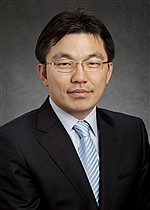 Hyunjoon Kong
Hyunjoon Kong
Department of Chemical & Biomolecular Engineering
University of Illinois at Urbana-Champaign
hjkong06@illinois.edu
Over the last decades, extensive efforts have been made to fabricate a platform that can culture stem cells or cancer cells of interest in a three-dimensional (3D) matrix, so one can use it for both fundamental and applied bioscience studies. A hydrogel formed from cross-linking between polymers dissolved in aqueous media is being widely used in design of the 3D matrix, because its hydrated environment is similar to the natural extracellular matrix. Successful use of the hydrogel greatly depends on the ability to independently tailor biochemical and biomechanical properties, which are known to modulate cellular growth and differentiation. However, conventional hydrogel design strategies often encountered complex dependencies between properties of the gel, for example, an inverse dependency between permeability and stiffness of the gel. Therefore, in this talk, we will present advanced biomaterial design principles we developed to decouple the inverse dependency between permeability and mechanics of the gel and elaborate effects of matrix mechanics on co-differentiation of stem cells and malignancy of cancer cells. In addition, we will demonstrate usefulness of the resulting gel to recreating new vascular networks with controlled spacing and further improving recovery of perfusion in ischemic tissue.
Hyunjoon Kong is an associate professor in the Department of Chemical and Biomolecular Engineering and a Centennial Scholar at the University of Illinois at Urbana-Champaign (UIUC). He also holds affiliations with the Department of Bioengineering, the Center for Biophysics and Computational Biology, and the Neuroscience Program. He received his engineering education from the University of Michigan at Ann Arbor (Ph.D. 2001), and performed post-doctoral research at the University of Michigan and Harvard University. He joined the University of Illinois in 2007. During his academic life, he has received a Scientist Development Grant from the American Heart Association, a Career Award from NSF, a Center for Advanced Study Fellowship, and the UIUC Engineering Dean’s Award for Research Excellence. To date, he has published 91 papers in various peer-reviewed journals.
His group’s overall goal is to develop advanced material systems useful for fundamental and applied biosciences. Specifically, they focus on creating simple, but novel methods to control nano- and micro-structure of materials inspired by nature and further modulate chemical and physical properties of materials, in an independent manner. In addition, they are exploring use of the resulting material systems in multiple applications, including drug delivery, diagnosis/bioimaging, 3D cell culture and therapies, and tissue repair and regeneration. In that context, their current research projects include:
- Differential controls of chemical, mechanical, and transport properties of bioactive hydrogels for 3D cell culture, cell transplantation, and revascularization therapies.
- Modular assembly of multifunctional nano- and microparticles for diagnosis, imaging, and treatment of cardiovascular diseases.
- Nanomaterial for target stem cell delivery.
- Stem/cancer cell clusters for understanding emergent cell behavior towards tissue development and pathogenesis.